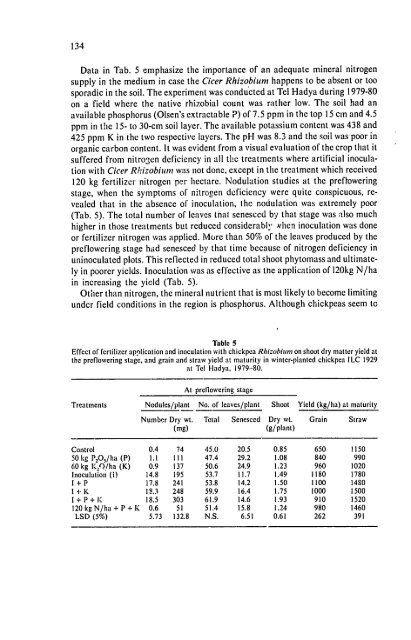I - --ii
I - --ii
I - --ii
You also want an ePaper? Increase the reach of your titles
YUMPU automatically turns print PDFs into web optimized ePapers that Google loves.
134<br />
Data in Tab. 5 emphasize the importance of an adequate mineral nitrogen<br />
supply in the medium in case the Cicer Rhizobium happens to be absent or too<br />
sporadic in the soil. The experiment was conducted at Tel Hadya during 1979-80<br />
on a field where the native rhizobial count was rather low. The soil had an<br />
available phosphorus (Olsen's extractable P) of 7.5 ppm in the top 15 cm and 4.5<br />
ppm in the 15- to 30-cm soil layer. The available potassium content was 438 and<br />
425 ppm K in the two respective layers. The pH was 8.3 and the soil was poor in<br />
organic carbon content. It was evident from a visual evaluation of the crop that it<br />
suffered from nitrogen deficiency in all the treatments where artificial inoculation<br />
with CicerRhizobium was not done, except in the treatment which received<br />
120 kg fertilizer nitrogen per hectare. Nodulation studies at the preflowering<br />
stage, when the symptoms of nitrogen deficiency were quite conspicuous, revealed<br />
that in the absence of inoculation, the nodulation was extremely poor<br />
(Tab. 5). The total number of leaves that senesced by that stage was also much<br />
higher in those treatments but reduced considerably vhen inoculation was done<br />
or fertilizer nitrogen was applied. More than 50% of the leaves produced by the<br />
preflowering stage had senesced by that time because of nitrogen deficiency in<br />
uninoculated plots. This reflected in reduced total shoot phytomass and ultimately<br />
in poorer yields. Inoculation was as effective as the application of 120kg N/ha<br />
in increasing the yield (Tab. 5).<br />
Other than nitrogen, the mineral nutrient that is most likely to become limiting<br />
under field conditions in the region is phosphorus. Although chickpeas seem to<br />
Table 5<br />
Effect of fertilizer application and inoculation with chickpea Rhizobiurnon shoot dry matter yield at<br />
the preflowering stage, and grain and straw yield at maturity in winter-planted chickpea ILC 1929<br />
at Tel Hadya, 1979-80.<br />
At preflowcring stage<br />
Treatments Nodules/plant No. of leaves/plant Shoot Yield (kg/ha) at maturity<br />
Number Dry wt. Total Senesced Dry wt. Grain Straw<br />
(mg)<br />
(g/plant)<br />
Control 0.4 74 45.0 20.5 0.85 650 1150<br />
50 kg P 20/ha (P) 1.1 111 47.4 29.2 1.08 840 990<br />
60 kg K 20/ha (K) 0.9 137 50.6 24.9 1.23 960 1020<br />
Inoculation () 14.8 195 53.7 11.7 1.49 1180 1780<br />
I + P 17.8 241 53.8 14.2 1.50 1100 1480<br />
1+ K 18.3 248 59.9 16.4 1.75 1000 1500<br />
1 + P + K 18.5 303 61.9 14.6 1.93 910 1520<br />
120 kg N/ha + P + K 0.6 51 51.4 15.8 1.24 980 1460<br />
LSD (5%) 5.73 132.8 N.S. 6.51 0.61 262 391

















